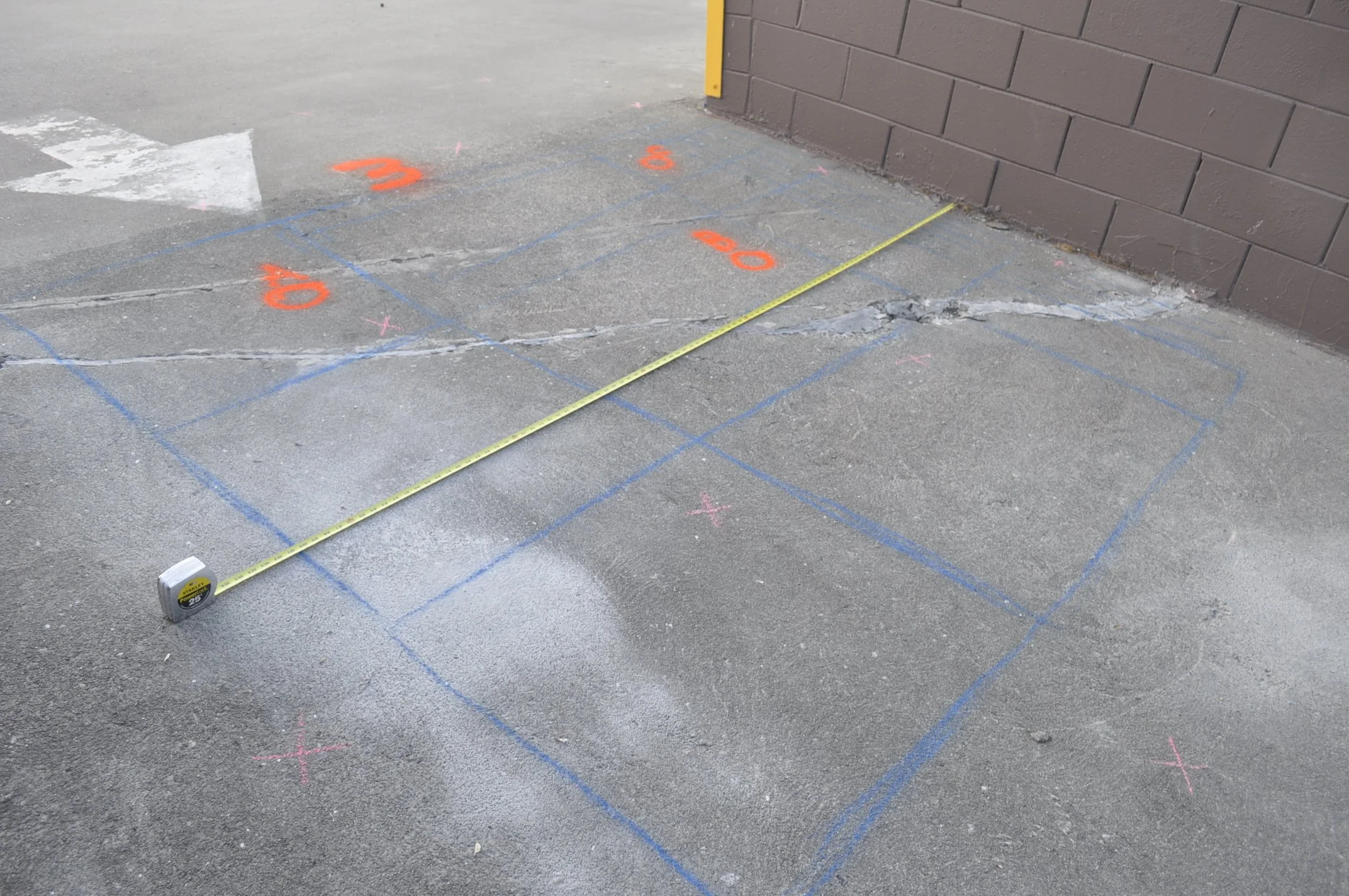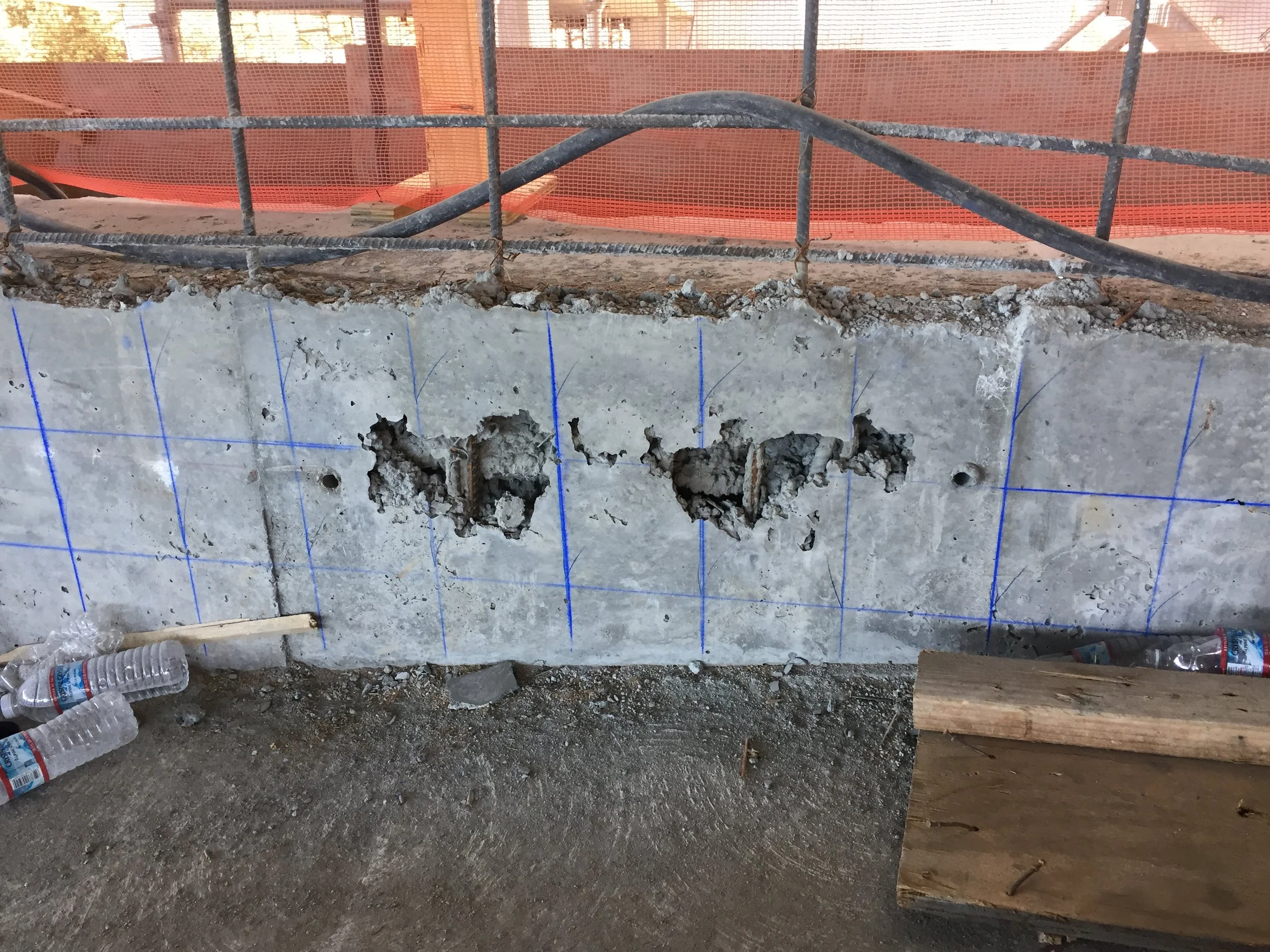Unlocking the Hidden World of Concrete with Ground Penetrating Radar Systems (GPRS)
Introduction
Understanding what lies within and beneath a concrete structure is critical for making safe, informed decisions during construction, renovation, or structural evaluation. At Concrete Science®, we rely on a variety of non-destructive testing (NDT) methods—such as the Schmidt hammer for surface strength estimation and ultrasonic testing for material integrity—to assess concrete without causing damage. Among these, few tools are as powerful or precise as ground penetrating radar (GPR). This technology gives us the ability to look deep inside concrete slabs and walls, revealing rebar, conduits, voids, and other embedded features that are otherwise invisible to the eye.
Markings on a concrete surface after GPRS scanning by Concrete Science®, identifying areas to avoid rebar before coring.
What Is Ground Penetrating Radar?
Ground Penetrating Radar Systems (GPRS) use electromagnetic waves to scan below the surface of materials like concrete, creating detailed images of what lies within and beneath the concrete member. By emitting radar pulses into the concrete, GPRS detects changes in material composition, reflecting signals to create a subsurface map. This non-invasive, non-destructive technology provides critical data without damaging the structure.
How GPR Works
Emission: The GPR system sends electromagnetic pulses into the concrete.
Penetration: These pulses travel through the material and interact with embedded objects or changes in material density. The depth of penetration depends on the frequency of the radar antenna.
Reflection: Pulses bounce back when encountering objects like rebar, conduits, or voids.
Detection: The returning signals are captured and processed into readable data, providing a detailed view of the structure's internal composition.
The photo shows work performed by Concrete Science® at a large warehouse project. The blue grid lines identify rebar locations and spacing. Identifying rebar locations helps identify potential core locations so that the coring does not cut the internal metal conduits or structural steel.
Why Concrete Science® Uses GPR
GPRS has become a cornerstone in concrete inspections due to its versatility and reliability. Key applications include:
1. Locating Embedded Objects
Concrete structures often contain rebar, post-tension cables, and electrical conduits that must be located before construction, renovation, or repair work begins. GPRS maps these elements, reducing the risk of costly damage and safety hazards.
2. Concrete Coring and Cutting
Before drilling or cutting through concrete, GPRS scans help pinpoint safe coring locations. This minimizes the chance of hitting critical structural components, preventing severe structural damage and costly repairs.
3. Condition Assessments
For assessing aging infrastructure, GPRS assists in determining if the structure is built per drawing. This helps engineers plan appropriate repairs, prolonging the life of the structure.
4. Structural Integrity Testing
In construction and repair projects, GPRS ensures quality control by verifying the placement and depth of reinforcing steel and embedded components as specified in design plans.
A successful concrete core sample is taken during a concrete slab investigation by Concrete Science®, avoiding rebar to preserve the structural integrity. The yellow polyurethane membrane visible at the base of the core is a moisture barrier installed over the soil and rocks before the concrete slab is poured.
Why Avoid Rebar During Coring
When performing concrete coring, avoiding rebar is critical to maintaining the structural integrity of a building. Rebar (reinforcing steel) provides tensile strength that helps concrete withstand tensile stresses. Accidentally cutting through rebar can weaken the structure, causing safety hazards and expensive repairs. Here’s why GPRS is essential:
Structural Safety: Cutting through rebar can compromise the entire structural system by reducing load-bearing capacity.
Cost Efficiency: Avoiding rebar prevents costly repairs, project delays, and additional inspections.
Damage Prevention: Striking embedded electrical conduits, plumbing lines, or post-tension cables can cause significant damage and unsafe conditions.
By using GPRS before coring, contractors can locate rebar and other embedded elements, ensuring safer and more efficient operations while preserving the structure’s integrity.
Benefits of Using GPR
The forensic civil engineers at Concrete Science® believe the following are the key benefits of GPRS.
Non-Destructive Testing: No drilling, coring, or cutting is required.
Enhanced Safety: Prevents accidental strikes on live electrical or pressurized lines.
Cost-Effective: Reduces the risk of costly repairs and project delays.
Accurate and Immediate Data: Delivers on-site results, enabling real-time decision-making.
Environmental Sustainability: Minimizes waste by reducing unnecessary, destructive testing.
Real-World Use Cases
Bridge Deck Evaluations: Identifying corrosion, delamination, and structural weaknesses.
Utility Detection: Mapping buried utilities and ensuring proper clearance.
Industrial Site Inspections: Locating buried tanks, pipelines, and underground hazards.
Rebar Verification: Ensuring rebar presence and correct spacing in concrete for optimal structural strength and integrity.
Damage to a concrete wall revealing exposed and corroded rebar. Blue grid markings from GPRS scanning highlight areas of investigation, ensuring proper rebar spacing and structural assessment for necessary repairs.
Final Thoughts
Ground-penetrating radar Systems (GPRS) have revolutionized concrete investigation by offering a safe, precise, and noninvasive way to uncover hidden structural elements. Whether used for construction inspections or structural assessments, GPRS ensures that engineers and contractors can make data-driven decisions with confidence.
At Concrete Science®, we rely on advanced technologies like GPRS to provide accurate assessments, minimize risks, and deliver exceptional results. Contact us today to learn how GPRS can support your next project and help maintain the safety and integrity of your concrete structures.
Consider Reading the Following
ACI 228.2R – Nondestructive Test Methods for Evaluation of Concrete in Structures





